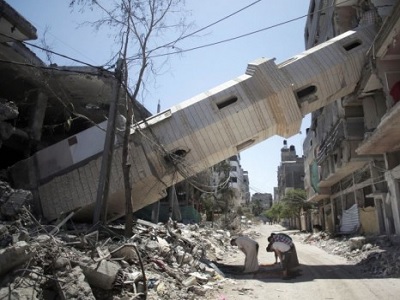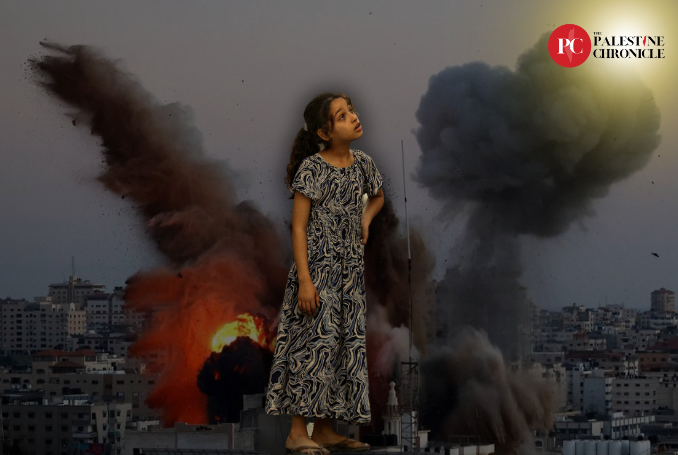
By Monir Birouk
Is there any relationship between modernity and resistance? Is every act of resistance necessarily modern? I entrust these questions to the wisdom of the philosophers. Here, my claim is rather modest: to train spotlight on the relation between modernity and resistance in light of the recent epic of resistance in Gaza. If we take the modern to be not only the new, but also the creative; if we take the modernist to be that who eschews subservience, imitation and conformity and aspires for singularity; and if modernity is teleologically set in motion by the will to freedom and liberty, then resistance in Gaza is a modernist act par excellence.
It is not meant to dispute Sartre here, but essence precedes existence. Without land, history, language and belief one can hardly said to be. When one’s land is occupied, history confiscated and one’s people is mass-enslaved, the only possible modern act at hand is to resist. Subjectification, subjugation and master-slave reconciliation are possible alternatives, but they are not modern. From the old days of the Intifida when bare-chested children threw their little stones at the Israeli tanks down to the resistance in Operation Criterion (2008) [Israeli code-named Cast Lead], Hard Clay (2012) [Pillar of Cloud] and the epic performance in the Eaten Straw (2014) [Protective Edge], the narrative of resistance is re-inscribed in new ways, takes new shapes and uses different tactics, but in essence, it is one and should always be. It is the practical pedagogy of the oppressed Palestinians in Gaza. Those frail little kids who used to fling their tiny stones at the occupier back in the days of the Intifada have grown up today and learnt to shell long-range missiles.
Palestinian resistance is also modern by dint of its progressive conception of time. The will to liberation and freedom is crafted in the crucible of history without being enslaved by the heavyweight and pain-fraught residues of the past nor crippled by the blood-soaked exigencies of the present. The defiant act of the colonized Palestinian is not severed from the past, and it is here that it parts ways with the narrative of modernity. For the Palestinian subject, memory is the locus of resistance, and the seed of its continuity. In the Palestinian palimpsest, the painful past is being evoked and activated to structure the logic of the present. The past is a “story to be told” not in the manner of Toni Morrison’s traumatized heroine in Beloved, nor in the tragic ways of Jean Rhys’s Antoinette in Wide Sargasso Sea. The story of pain is a story to be told only so long that it fuels the Cogito of the oppressed: “I resist, I exist”.
Yes, the Palestinian resistance is modern. It is so because, in addition to annihilation, Palestinians also defy representation in its two senses: political proxy and the literary/figurative rendering. Stripped of their political agency before the international community, people in Gaza are always meant to be spoken for and on their behalf in the political discourse. It does not matter by whom and where, since the agenda is the same. Whether in the corridors of the UN, the sell-out Palestinian Authority in the West Bank or by the hostile rancor-filled Arab neighbors resistance in Gaza is misrepresented, bedeviled and demonized.
Because of its unwillingness to succumb to the incurred tutelage and guardianship of those brokers, Gaza pays, and pays dearly. To echo, it is for their nonconformity that the “world whips [them] with its displeasure.” How many deaths are still required and how long should the Palestinians in Gaza resist before somebody is inspired to write a manifesto of resistance [perhaps titled “What is Resistance?”], which echoes and parallels the grandor of Kant’s “What is Enlightenment?”?
In Gaza, resistance also creates, innovates and certainly baffles, and these acts make up the ingredients of the modern. The talk here is not about how people fare in a ghetto which is sealed from the land, the sea and the air, how they make ends meet, and how they bow in underground tunnels to avoid the humiliation of prostrating themselves to their enemies on the ground. That is another story. It is rather the creativity of the resistance on the battle ground that I am interested in. To force one of the best and highly equipped and ruthless armies in the world to unilaterally withdraw from Gaza without being able to re-occupy an inch is a telling sign of the caliber of the resistance. Israel, it seems, has bitten more than it can chew.
What is modern surprises, baffles and sometimes even shocks. Any regular follower of the Israeli media will have no shred of doubt that the Israeli army was reeling from the scores of the armed resistance in Gaza. Hamas fighters ventured behind the lines of the Israeli army on several occasions, faced and fought incomparably equipped soldiers from point zero, successfully sent locally-made drones to the Israeli air zones, locally developed rockets which reached the hinterlands of the occupied territories, and invented the Ghoul sniper with 2 km range. In the scale of success, to be able to make these achievements in little time and with very meager resources makes much difference. The bill on the other side is shocking: rejection of military service, tight-reigns on the IDF death toll, soldiers holed-up in their tanks and trembling. On the Palestinian side, death is a badge of pride; on the other, it is a shame. On one side, there is courage; on the other, only technology compensates for fear and trembling! As Ronen Bergman puts it in an article in New York Times on August 10, “if body-counts and destroyed weaponry are the main criteria for victory, Israel is the clear winner”, but if the criterion is the extent to which pre-set goals are achieved, then “Hamas won.”
Modernity is also inexorably interlaced with agency and history. To be sure, resistance in Gaza is making history these days. Experts and pundits in the Middle East affairs have already foreseen its disruptive power. With its creative achievements and innovative tactics, the resistance achieved for the first time a balance of power which forces Israel not only to press through its Western and Arab brokers for a truce, but to sit at the negotiation table. Negotiations between equals, and not between the master and slave, as was the case in Oslo.
Resistance in Gaza forces its version of the present when it exposed the post-Arab Spring strategic regional and international alliances whose agenda was meant to be on the low. That the war in Gaza has been orchestrated and carried out by IDF, partially funded by UAE [Israel Channel Two on July 15], politically and theologically legitimized by Saudi Arabia and facilitated on all fronts by Egypt is no secret. On the margins of the post-Arab Spring defeatist discourse emerged a counter-discourse which revived the hope which drove those freedom-longing souls who took to the streets and public squares in the Arab world three years ago. One more achievement: the Zionist Arabs becomes a registered brand!
Last word, resistance is in full-blown modernity when it holds out against and combats the atrocities, the horrors, the deceptions and misconceptions which are perpetrated in the very name of modernity. The modern is the moral, and the moral is the human. Resistance is grievingly very costly; but a fast death is far less costly than a slow and humiliating one. But it is the will to life, and not death, that drives people in Gaza to resist. It is because they want to live and not to survive that they will soon wipe off their tears, cast away the rubbles, rebuild their houses even if they know the latter will soon be shelled again, go to schools for miles on foot, hold classes in the open air, dig more tunnels, and of course plan for the next battle and extend the range of the Ghoul sniper. Twisting Marcus Aurelius’s words, when death smiles, all a man can do in Gaza is, not smile back, but fight back.
(‘On Resistance and Modernity’ is borrowed from Taha Abdurrahman’s book Modernity and Resistance.)
– Monir Birouk is a native Moroccan intellectual and writer. He contributed this article to PalestineChronicle.om.






Bravo Monir! a cogent , perceptive analysis.